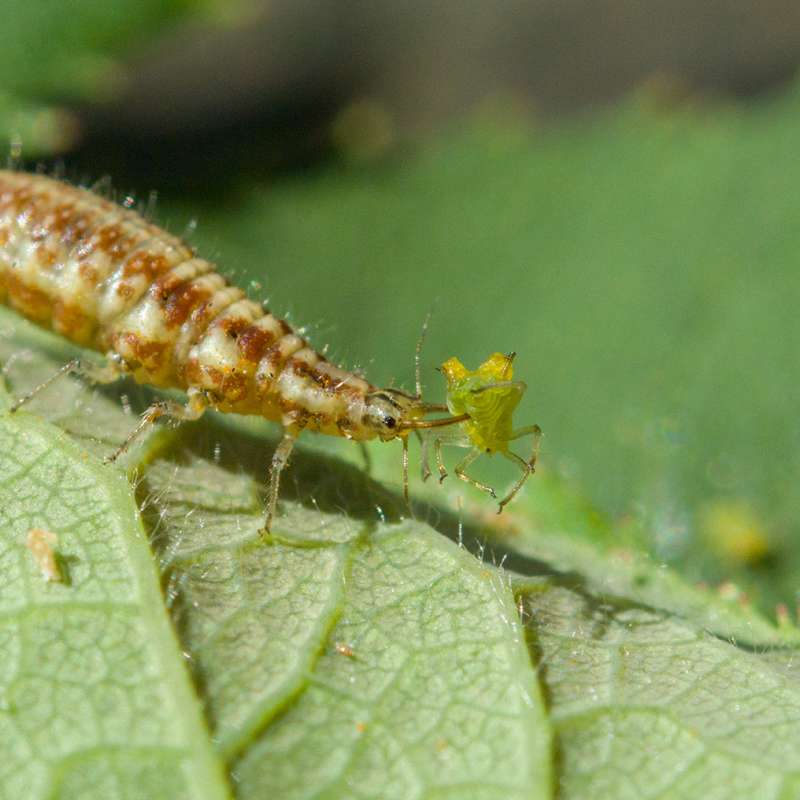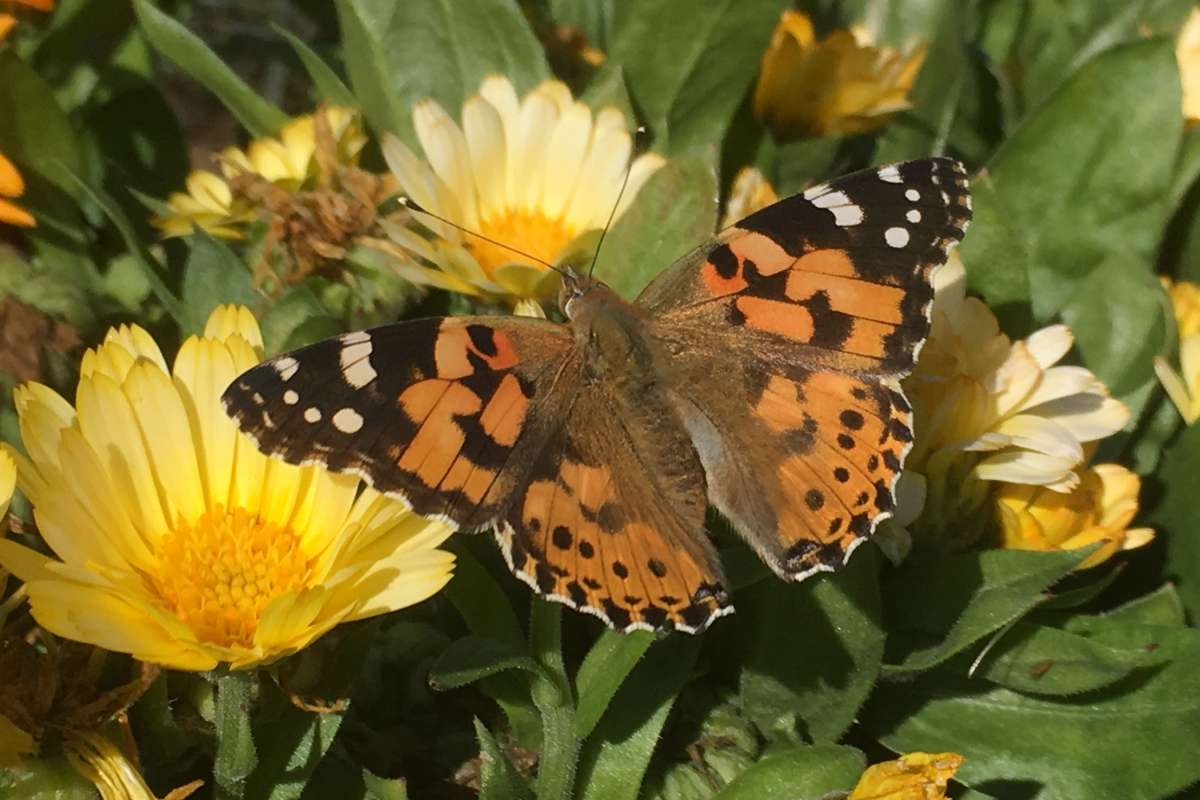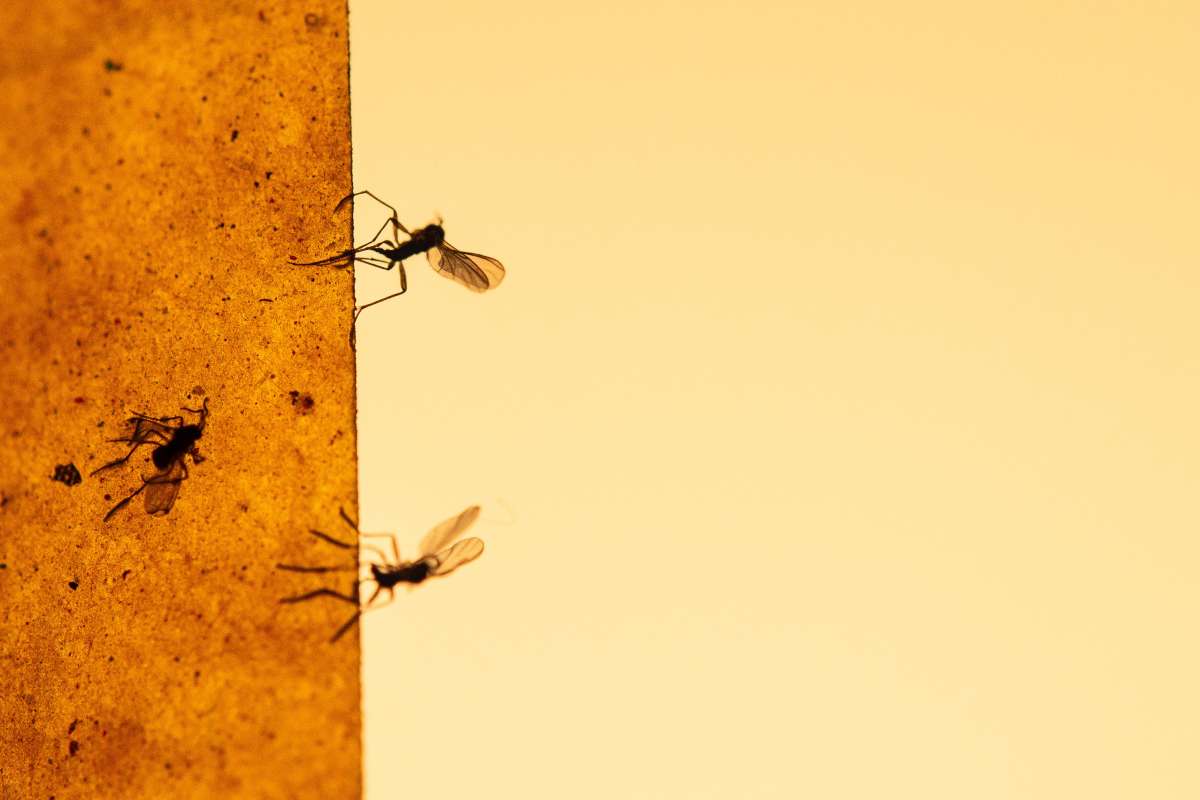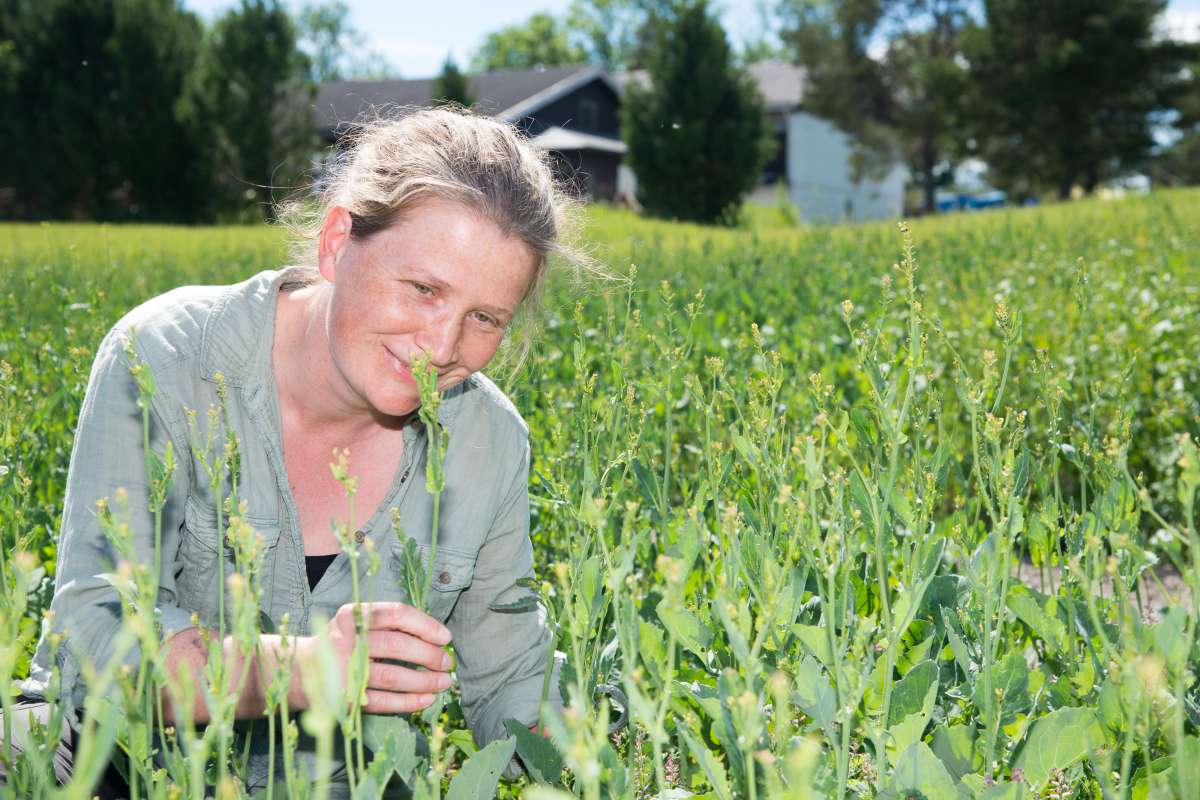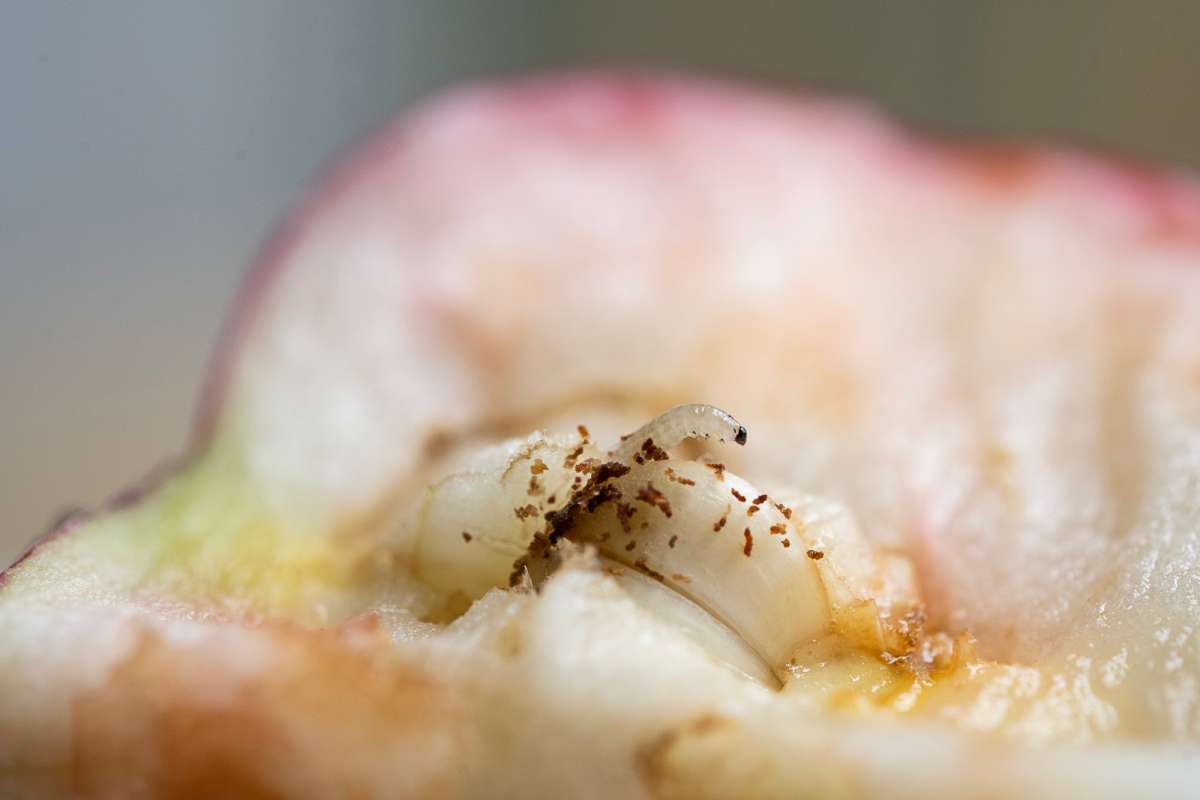
Skade- og nytteorganismer
Blant insekter, midd og snegl har vi både SKADE- og NYTTEDYR. De omtales gjerne som SKADEDYR når de angriper planter som vi dyrker til mat, fôr eller som prydplanter. Videre omtales de som NYTTEDYR når de dreper skadedyr eller når de hjelper til med pollinering av planter. Insekter kan også brukes som protein og fettkilde i fôr til husdyr og som mat til mennesker.
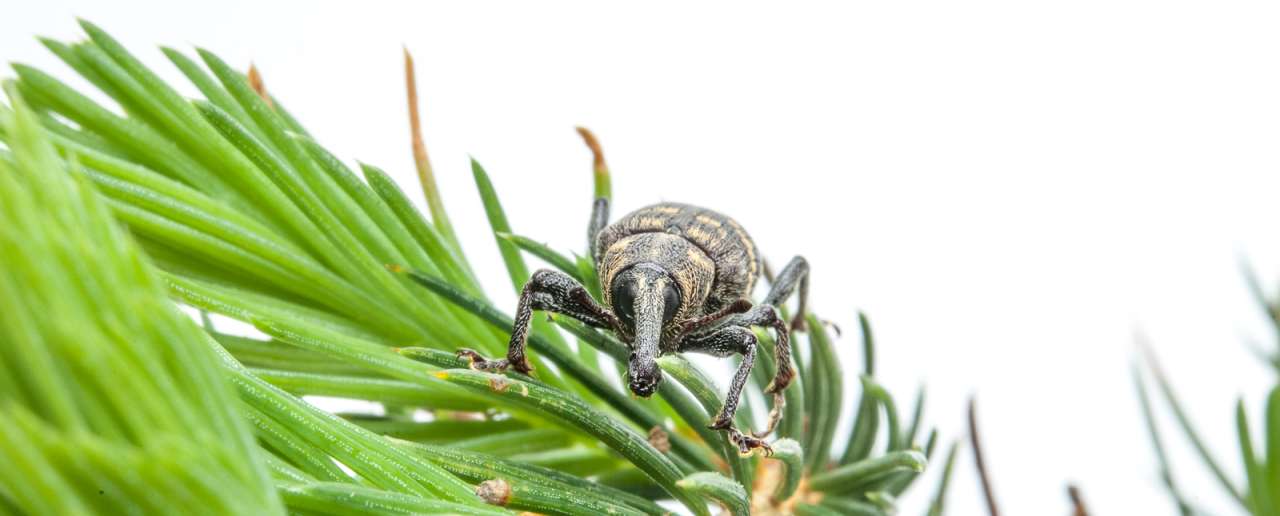
NIBIO har den største samlede fagkompetansen innen insekter, midd og snegl som skade- og nyttedyr i Norge. Vi utfører forsknings-, utviklings- og innovasjonsarbeid innen overvåking, biologi og bekjempelse av skadedyr i landbruk, skogbruk, planteskoler, juletrefelt og grøntarealer».
Arbeidet ved NIBIO fokuserer for tiden på følgende temaer:
- Diagnostikk av skade- og nyttedyr
- Biologi, økologi og bekjempelse av skadegjørerne
- Overvåking av skadegjørere i skog
- Samspill mellom planter skadedyr og deres naturlige fiender
- Integrert plantevern (IPV) inkludert: Utarbeidelse av varslingsmodeller, bruk av sensorikk for presis bekjempelse og varsling, håndtering av plantevernmiddelresistens
- Alternative kontrollmetoder inkludert: Bioteknisk bekjempelse (signalstoffer mm), biologisk kontroll, fysisk bekjempelse og forebyggende tiltak
- Agronomisk utprøving av kjemiske og biologiske plantevernmidler
- Karanteneskadegjørere og fremmede invaderende arter
- Bruke organismekompetansen utover tradisjonelt plantevern inkludert oppgaver innen biodiversitet, vektorer, pollineringsøkologi, bioaktive stoffer, insekter som proteinkilde
Tjenester
Planteklinikken
Planteklinikken ved NIBIO er et diagnoselaboratorium som tilbyr identifisering av ulike organismer som er skadelige for planter. Riktig diagnose danner grunnlag for å vurdere riktige tiltak mot skadegjøreren.
Mer informasjon Til tjenestenPlantevernguiden
Plantevernguiden er en nettbasert tjeneste som gir deg en samlet oversikt over godkjente kjemiske og biologiske plantevernmidler. Tjenesten er utviklet i et samarbeid mellom Mattilsynet og NIBIO.
Mer informasjon Til tjenestenPlantevernleksikonet
Nettside med nyttig og relevant informasjon om biologi og bekjempelse av planteskadegjørere (ugras, sykdommer og skadedyr). Du finner også informasjon om biologien til en del nyttedyr av plantevernbetydning.
Mer informasjon Til tjenestenVIPS
Varsling innen planteskadegjørere
Mer informasjon Til tjenestenPublikasjoner
Forfattere
Philipp Lehmann Tea Ammunet Madeleine Barton Andrea Battisti Sanford D. Eigenbrode Jane Uhd Jepsen Gregor Kalinkat Seppo Neuvonen Pekka Niemelä John S. Terblanche Bjørn Økland Christer BjörkmanSammendrag
Det er ikke registrert sammendrag
Forfattere
Hanno Sandvik Olga Hilmo Snorre Henriksen Reidar Elven Per Arvid Åsen Hanne Hegre Oddvar Pedersen Per Anker Pedersen Heidi Solstad Vigdis Vandvik Kristine Bakke Westergaard Frode Ødegaard Sandra Charlotte Helene Åström Hallvard Elven Anders Endrestøl Øivind Gammelmo Bjørn Arild Hatteland Halvor Solheim Björn Nordén Leif Sundheim Venche Talgø Tone Falkenhaug Bjørn Gulliksen Anders Jelmert Eivind Oug Jan Henry Sundet Elisabet Forsgren Anders Gravbrøt Finstad Trygve H. Hesthagen Kjell Harald Nedreaas Rupert Wienerroither Vivian Husa Stein Fredriksen Kjersti Sjøtun Henning Steen Haakon Hansen Inger Sofie Hamnes Egil Karlsbakk Christer Magnusson Bjørnar Ytrehus Hans Christian Pedersen Jon Swenson Per Ole Syvertsen Bård Gunnar Stokke Jan Ove Gjershaug Dag Dolmen Gaute Kjærstad Stein Ivar Johnsen Thomas Correll Jensen Kristian Hassel Lisbeth GederaasSammendrag
This is an open access article under the terms of the Creative Commons Attribution License, which permits use,distribution and reproduction in any medium, provided the original work is properly cited.c 2020 The Authors. Ecological Solutions and Evidence published by John Wiley & Sons Ltd on behalf of British Ecological Society
Sammendrag
Det er ikke registrert sammendrag
Sammendrag
Det er ikke registrert sammendrag
Forfattere
Bjørn Økland Daniel Flø Martin Schroeder Peter Zach Dragos Cocos Petri Martikainen Juha Siitonen Michail Y. Mandelshtam Dmitry L. Musolin Seppo Neuvonen Jozef Vakula Christo Nikolov Åke Lindelöw Kaljo VoolmaSammendrag
Det er ikke registrert sammendrag
Forfattere
Anna Maria Vettraino Alberto Santini Christo Nikolov Jean-Claude Grégoire Rumen Tomov Andrei Orlinski Tiit Maaten Halldor Sverrisson Bjørn Økland René EschenSammendrag
Sentinel plants, plants in exporting countries that are inspected at regular intervals for signs and symptoms of invertebrate pests and microbial pathogens, are a promising tool for detecting and identifying harmful organisms of woody plants prior to their introduction into importing countries. Monitoring of sentinel plants reveals crucial information for pest risk analyses and the development of mitigation measures. The establishment of sentinel plants requires the import and plantation of non-native plants, which may be affected by the laws, regulations and administrative procedures in the individual countries. To evaluate the feasibility of sentinel plants as a global approach, this study aimed to summarise regulations and administrative procedures that affect the establishment of sentinel plants using non-native plants in countries worldwide. Information about national regulations of import and planting of non-native plant species was collected through a questionnaire survey, conducted among national representatives to the International Plant Protection Convention. Over 40 countries responded. The results show that legislations and regulations should not be major obstacles for a global use of the sentinel plants approach. However, the few existing experiences show that it can be complicated in practice. Here we describe the current state of art of the procedures that should be adopted to establish sentinel plants and we propose a strategy to circumvent the shortcomings resulting from the lack of a specific regulation.
Forfattere
Hanno Sandvik Dag Dolmen Reidar Elven Tone Falkenhaug Elisabet Forsgren Haakon Hansen Kristian Hassel Vivian Husa Gaute Kjærstad Frode Ødegaard Hans Christian Pedersen Halvor Solheim Bård Gunnar Stokke Per Arvid Åsen Sandra Åström Tor Erik Brandrud Hallvard Elven Anders Endrestøl Anders Gravbrøt Finstad Stein Fredriksen Øivind Gammelmo Jan Ove Gjershaug Bjørn Gulliksen Inger Hamnes Bjørn Arild Hatteland Hanne Hegre Trygve Hesthagen Anders Jelmert Thomas C Jensen Stein Ivar Johnsen Egil Karlsbakk Christer Magnusson Kjell Nedreaas Björn Nordén Eivind Oug Oddvar Pedersen Per Anker Pedersen Kjersti Sjøtun Jon Kristian Skei Heidi Solstad Leif Sundheim Jon E Swenson Per Ole Syvertsen Venche Talgø Vigdis Vandvik Kristine B Westergaard Rupert Wienerroither Bjørnar Ytrehus Olga Hilmo Snorre Henriksen Lisbeth GederaasSammendrag
This is a post-peer-review, pre-copyedit version of an article published in [Biological Invasions] Locked until 3.8.2020 due to copyright restrictions. The final authenticated version is available online at: https://doi.org/10.1007/s10530-019-02058-x
Forfattere
Kamila S. Zając Bjørn Arild Hatteland Barbara Feldmeyer Markus Pfenninger Anna Filipiak Leslie Robert Noble Dorota Lachowska-CierlikSammendrag
Paid Open Access
Sammendrag
In the family Orchidaceae, many species have highly specialised floral structures and floral fragrances resulting from interactions with specific pollinators. Olfactory cues are important for the moths to locate orchids at a distance, whereas visual cues are important at a closer range. In this study, we combined a portable air entrainment kit with an automated video monitoring system for collecting volatiles and observing behaviour directly around-the-clock (24 h) in the natural habitat of our target plant–arthropod system, the orchid Platanthera chlorantha and the hawkmoth Sphinx pinastri. We found that P. chlorantha was visited almost exclusively by S. pinastri. All the visits occurred after sunset, principally between sunset and midnight. Soon after midnight, visits dropped to levels recorded at sunset, then declined further towards sunrise. The period with most visits matched the peak production of the terpenoids (Z)-β-ocimene and (E)-β-ocimene. In contrast, linalool, (E)-cinnamyl alcohol and benzyl benzoate emission continued to increase beyond the period of peak visits up to sunrise. Methyl benzoate emissions declined throughout the night from a sunset peak. As temporal emission of the two volatile ocimenes from P. chlorantha flowers matches S. pinastri foraging visits to the flowers, we propose that they play a vital role in assisting hawkmoths locate their hosts. This is the first study to show correspondence in the timing of specific scent emissions in orchids and moth activity on the scale of hours.
Sammendrag
Det er ikke registrert sammendrag
Forfattere
Fernanda Canassa Fernanda C. N. Esteca Rafael A. Moral Nicolai Vitt Meyling Ingeborg Klingen Italo DelaliberaSammendrag
Det er ikke registrert sammendrag
Forfattere
Fernanda Canassa Celeste P. D'Alessandro Sidcleide B. Sousa Clarice G. B. Demétrio Nicolai Vitt Meyling Ingeborg Klingen Italo Delalibera Jr.Sammendrag
Det er ikke registrert sammendrag
Forfattere
Jørgen Eilenberg Stephanie Saussure Ibtissem Ben Fekih Annette Bruun Jensen Ingeborg KlingenSammendrag
Pandora neoaphidis and Entomophthora planchoniana are widespread and important specialist fungal pathogens of aphids in cereals (Sitobion avenae and Rhopalosiphum padi). The two aphid species share these pathogens and we compare factors influencing susceptibility and resistance. Among factors that may influence susceptibility and resistance are aphid behavior, conspecific versus heterospecific host, aphid morph, life cycle, and presence of protective endosymbionts. It seems that the conspecific host is more susceptible (less resistant) than the heterospecific host, and alates are more susceptible than apterae. We conceptualize the findings in a diagram showing possible transmission in field situations and we pinpoint where there are knowledge gaps.
Sammendrag
Det er ikke registrert sammendrag
Sammendrag
Det er ikke registrert sammendrag
Sammendrag
Green-sprouting potato seed tubers in light and elevated temperatures are vital for production in short-season climates. Using light-emitting diodes (LEDs) to inhibit sprout elongation during pre-sprouting may represent an energy-efficient alternative to traditional indoor light sources. Sprout growth inhibition and some photomorphogenic responses were therefore examined in potato cultivars exposed to LEDs of different wavelength maxima and irradiance rates. Red LED (660 nm) produced the strongest inhibition of sprout elongation at very low irradiances 10–100 nmol m−2 s−1, while far-red LED (735 nm) produced the strongest inhibition at higher irradiances. This inhibitory pattern was similar in all cultivars, although the degree of inhibition varied. The colour of sprouts and tuber skin remained etiolated under far-red LED, in contrast to LEDs between 380 and 660 nm which developed green colour intensity in an irradiance-dependent manner. Mixtures of red and far-red light, and pulses including red/far-red reversals did not produce stronger inhibition, except in some instances where total fluence was increased. Furthermore, green-sprouting under different LED colours did not seem to affect subsequent emergence and growth after planting. The current results suggest an involvement of multiple phytochromes in de-etiolation and sprout growth inhibition in seed potato tubers, which may be selectively utilised in LED-based green-sprouting in red and far-red wavelengths.
Sammendrag
Det er ikke registrert sammendrag
Sammendrag
Det er ikke registrert sammendrag
Forfattere
Juraj Galko Bjørn Økland Troy Kimoto Slavomír Rell Milan Zúbrik Andrej Kunca Jozef Vakula Andrej Gubka Christo NikolovSammendrag
A warmer climate may potentially have a strong effect on the health status of European oak forests by weakening oak trees and facilitating mass reproduction of wood boring insects. We did a laboratory experiment in Slovakia to study the response of major pest beetles of oak and their parasitoids to different temperature regimes as background for predicting climatic effects and improving management tools of European oak forests. With higher temperatures the most important oak pest Scolytus intricatus emerged much earlier, which indicate that completion of a second generation and increased damage further north in European oak forests may be possible. Lower temperatures gave longer larval galleries and more offspring per parents but still lower beetle production due to semivoltine life cycle. For buprestids and longhorn beetles warmer temperatures resulted in more emerging offspring and a shift towards earlier emergence in the same season, but no emergence in the first season indicated that a change to univoltine populations is not likely. Reduced development success of parasitoids at the highest temperatures (25/30 °C) indicates a loss of population regulation for pest beetle populations. A warmer climate may lead to invasion of other population-regulating parasitoids, but also new serious pest may invade. With expected temperature increases it is recommended to use trap trees both in April and in June, and trap trees should be removed within 2 months instead 1 year as described in the current standard.
Sammendrag
submittedVersion
Sammendrag
Det er ikke registrert sammendrag
Sammendrag
Det er ikke registrert sammendrag
Forfattere
Fernanda de Cássia Neves Esteca Luis Rodolfo Rodrigues Gilberto José de Moraes Italo, Júnior Delalibera Ingeborg KlingenSammendrag
Det er ikke registrert sammendrag
Forfattere
Thiago Castro Rafael de Andrade Moral Clarice Garcia Borges Demétrio Italo Jr. Delalibera Ingeborg KlingenSammendrag
Det er ikke registrert sammendrag
Sammendrag
We investigated the ability of the fungal entomopathogen Beauveria bassiana strain GHA to endophytically colonize sugarcane (Saccharum officinarum) and its impact on plant growth. We used foliar spray, stem injection, and soil drench inoculation methods. All three inoculation methods resulted in B. bassiana colonizing sugarcane tissues. Extent of fungal colonization differed significantly with inoculation method (χ2 = 20.112, d. f. = 2, p < 0.001), and stem injection showed the highest colonization level followed by foliar spray and root drench. Extent of fungal colonization differed significantly with plant part (χ2 = 33.072, d. f. = 5, p < 0.001); stem injection resulted in B. bassiana colonization of the stem and to some extent leaves; foliar spray resulted in colonization of leaves and to some extent, the stem; and soil drench resulted in colonization of roots and to some extent the stem. Irrespective of inoculation method, B. bassiana colonization was 2.8 times lower at 14–16 d post inoculation (DPI) than at 7–10 DPI (p = 0.020). Spraying leaves and drenching the soil with B. bassiana significantly (p = 0.01) enhanced numbers of sett roots. This study demonstrates for the first time that B. bassiana can endophytically colonize sugarcane plants and enhance the root sett and it provides a starting point for exploring the use of this fungus as an endophyte in management of sugarcane pests.
Sammendrag
Det er ikke registrert sammendrag
Forfattere
C.A. Baroffio L. Sigsgaard E.J. Ahrenfeldt Anna-Karin Borg-Karlson Sara Andrea Bruun J.V. Cross M.T. Fountain D. Hall R. Mozuraitis B. Ralle Nina Trandem Atle WibeSammendrag
Most horticultural crops are attacked by more than one insect pest. As broad-spectrum chemical control options are becoming increasingly restricted, there is a need to develop novel control methods. Semiochemical attrac- tants are available for three important horticultural pests, strawberry blossom weevil, Anthonomus rubi Herbst (Coleoptera: Curculionidae), European tarnished plant bug, Lygus rugulipennis Poppius (Hemiptera: Miridae) and raspberry beetle, Byturus tomentosus deGeer (Coleoptera: Byturidae). Traps targeting more than one pest species would be more practical and economical for both monitoring and mass trapping than traps for single-species. In this study we aimed to (1) improve the effectiveness of existing traps for insect pests in strawberry and raspberry crops by increasing catches of each species, and (2) test if attractants for two unrelated pest species could be combined to capture both in the same trap without decreasing the total catches. Field tests were carried out in four European countries and different combinations of semiochemicals were compared. A volatile from straw- berry flowers, 1,4 dimethoxybenzene (DMB), increased the attractiveness of the aggregation pheromone to both sexes of A. rubi. The host-plant volatile, phenylacetaldehyde (PAA), increased the attraction of female L. rugu- lipennis to the sex pheromone, and, in strawberry, there was some evidence that adding DMB increased catches further. Traps baited with the aggregation pheromone of A. rubi, DMB, the sex pheromone of L. rugulipennis and PAA attracted both target species to the same trap with no significant difference in catches compared to those single-species traps. In raspberry, catches in traps baited with a combination of A. rubi aggregation pheromone, DMB and the commercially available lure for B. tomentosus, based on raspberry flower volatiles, were similar to those in single-species traps. In both crops the efficiency of the traps still needs improvement, but the multi- species traps are adequate for monitoring and should not lead to confusion for the user as the target species are easy to distinguish from each other.
Sammendrag
Det er ikke registrert sammendrag
Forfattere
Umberto Salvagnin Mickael Malnoy Gunda Thöming Marco Tasin Silvia Carlin Stefan Martens Urska Vrhovsek Sergio Angeli Gianfranco AnforaSammendrag
Det er ikke registrert sammendrag
Sammendrag
submittedVersion
Forfattere
Lorenzo Marini Bjørn Økland Anna Maria Jönsson Barbara Bentz Allan Carroll Beat Forster Jean-Claude Grégoire Rainer Hurling Louis Michel Nageleisen Sigrid Netherer Hans Peter Ravn Aaron Weed Martin SchroederSammendrag
Bark beetles are among the most devastating biotic agents affecting forests globally and several species are expected to be favored by climate change. Given the potential interactions of insect outbreaks with other biotic and abiotic disturbances, and the potentially strong impact of changing disturbance regimes on forest resources, investigating climatic drivers of destructive bark beetle outbreaks is of paramount importance. We analyzed 17 time-series of the amount of wood damaged by Ips typographus, the most destructive pest of Norway spruce forests, collected across 8 European countries in the last three decades. We aimed to quantify the relative importance of key climate drivers in explaining timber loss dynamics, also testing for possible synergistic effects. Local outbreaks shared the same drivers, including increasing summer rainfall deficit and warm temperatures. Large availability of storm-felled trees in the previous year was also strongly related to an increase in timber loss, likely by providing an alternative source of breeding material. We did not find any positive synergy among outbreak drivers. On the contrary, the occurrence of large storms reduced the positive effect of warming temperatures and rainfall deficit. The large surplus of breeding material likely boosted I. typographus population size above the density threshold required to colonize and kill healthy trees irrespective of other climate triggers. Importantly, we found strong negative density dependence in I. typographus that may provide a mechanism for population decline after population eruptions. Generality in the effects of complex climatic events across different geographical areas suggests that the large-scale drivers can be used as early warning indicators of increasing local outbreak probability.
Sammendrag
Angiostoma norvegicum n. sp. (Angiostomatidae) is described from the oesophagus, crop and the buccal mass of five species of slugs of the family Arionidae, Arion vulgaris (Moquin-Tandon), Arion ater (L.), Arion fasciatus (Nilsson), Arion fuscus (Müller) and Arion rufus/Arion ater hybrid), collected throughout Norway. Angiostoma norvegicum n. sp. was found parasitising arionids at seven of the 30 sample sites examined (23.3%), and 9.9% of all Arion spp. were infected with this nematode. The new species is characterised by its large size (4.0–8.6 mm long) and in having: lateral alae; 6 + 6 papillae at the cephalic end; a large circular mouth aperture; a spacious stoma; a pharyngeal basal bulb without valvular apparatus; an excretory pore near the base of bulb; a distal part of posterior ovary always outstretched; an anterior ovary distally nearly always outstretched; a vulva situated anterior to mid-body; long, nearly straight spicules and a small gubernaculum; three circumcloacal papillae and caudal genital papillae (GP) arranged in a pattern 1+2/3+3 with GP 5 and GP 8 opened on dorsal side of narrow bursa not reaching tail tip; short conical tails in both sexes with tips supplied by 4 short, unequal denticles. Morphologically, A. norvegicum n. sp. is similar to Angiostoma limacis Dujardin, 1845, which diagnostic characteristics are given based on examination of specimens from Norway and the UK. Conversely, the phylogenetic analyses based on D2D3 large subunit (LSU) rRNA gene sequences performed in the present study did not support the morphological affinity of these two species. Phylogenetic analyses demonstrated that although Angiostoma spp. cluster together, A. norvegicum n. sp. forms a tight monophyletic clade with the milacid nematode parasites Angiostoma margaretae Ross, Malan & Ivanova, 2011 and Angiostoma milacis Ivanova & Wilson, 2009.
Sammendrag
Despite global deforestation some regions, such as Europe, are currently experiencing rapid reforestation. Some of this is unintended woodland encroachment onto farmland as a result of reduced livestock pasture management. Our aim was to determine the likely impacts of this on exposure to ticks and tickborne disease risk for sheep in Norway, a country experiencing ecosystem changes through rapid woodland encroachment as well as increases in abundance and distribution of Ixodes ricinus ticks and tick-borne disease incidence. We conducted surveys of I. ricinus ticks on ground vegetation using cloth lure transects and counts of ticks biting lambs on spring pastures, where lambs are exposed to infection with Anaplasma phagocytophilum, the causative agent of tick-borne fever in livestock. Pastures had higher densities of I. ricinus ticks on the ground vegetation and more ticks biting lambs if there was more tree cover in or adjacent to pastures. Importantly, there was a close correlation between questing tick density on pastures and counts of ticks biting lambs on the same pasture, indicating that cloth lure transects are a good proxy of risk to livestock of tick exposure and tick-borne disease. These findings can inform policy on environmental tick control measures such as habitat management, choice of livestock grazing area and off-host application of tick control agents.
Sammendrag
Fields experiments were conducted during two growing seasons (2010–2011 and 2012–2013) at three seeding dates to identify stink bug (Hemiptera: Pentatomidae) species and to determine their seasonal population density fluctuation and damage caused to three common bean (Phaseolus vulgaris L.) cultivars “Ica Pijao,” “Cubacueto 25–9,” and “Chévere.” Stink bug species observed were Nezara viridula (L.), Piezodorus guildinii (Westwood), Chinavia rolstoni (Rolston), Chinavia marginatum (Palisot de Beauvois), and Euschistus sp. The most prevalent species was N. viridula in both seasons. The largest number of stink bugs was found in beans seeded at the first (mid September) and third (beginning of January) seeding dates. Population peaked at BBCH 75 with 1.75, 0.43, and 1.25 stink bugs/10 plants in 2010–2011 and with 2.67, 0.45, and 1.3 stink bugs/10 plants in 2012–2013 in the fields seeded the first, second, and third seeding dates, respectively. The lowest numbers of stink bugs were found in beans seeded at the second (mid November) seeding date. A significant negative correlation between relative humidity and number of stink bugs was found in 2010–2011, and a similar tendency was observed in 2012–2013. The highest seed and pod damage levels occurred in cv. “Chévere” and the lowest in cv. “ICA Pijao” during both seasons. Results suggest that cv. “ICA Pijao” and the second (mid November) seeding date is the best choice to reduce stink bug damage.
Sammendrag
The aim of this study was to evaluate the natural occurrence of Beauveria spp. in soil, from infections in the stink bug Piezodorus guildinii, an important pest of common bean (Phaseolus vulgaris) and as endophytes in bean plant tissue. Twelve conventional and 12 organic common bean fields in the Villa Clara province, Cuba were sampled from September 2014 to April 2015. One hundred and fifty Beauveria isolates were obtained from soil samples, bean plant parts and stink bugs. The overall frequency of occurrence of Beauveria isolates in conventional fields (8.4%) was significantly lower than that in organic fields (23.6%). Beauveria were also obtained significantly more frequently from bean roots in organic fields (15.0%) compared to bean roots in conventional fields (3.3%). DNA sequencing of the intergenic Bloc region was performed for Beauveria species identification. All isolates where characterized as Beauveria bassiana (Balsamo-Crivelli) Vuillemin, and clustered with isolates of neotropical origin previously described as AFNEO_1. The Cuban B. bassiana isolates formed five clusters in the phylogeny. Isolates of two clusters originated from all four locations, organic and conventional fields, as well as soil, plants and stink bugs. Organic fields contained isolates of all five clusters while conventional fields only harbored isolates of the two most frequent ones. Mating type PCR assays revealed that mating type distribution was skewed, with MAT1/MAT2 proportion of 146/4, indicating limited potential for recombination. The present study is the first to report of B. bassiana as a naturally occurring endophyte in common bean. Further, it shows that B. bassiana occurs naturally in diverse environments of common bean fields, and constitutes a potential reservoir of natural enemies against pest insects particularly in organic fields.
Forfattere
Michelle T. Fountain Catherine Baroffio Anna-Karin Borg-Karlson Phil Brain Jerry V. Cross Dudley I. Farman David R. Hall Baiba Ralle Paolo Rendina Pauline Richoz Lene Sigsgaard Sverre Storberget Nina Trandem Atle WibeSammendrag
Strawberry blossom weevil (SBW), Anthonomus rubi Herbst (Coleoptera: Curculionidae) and European tarnished plant bug (ETB), Lygus rugulipennis Poppius (Hetereoptera: Miridae), cause significant damage to strawberry and raspberry crops. Using the SBW aggregation pheromone and ETB sex pheromone we optimized and tested a single trap for both species. A series of field experiments in crops and seminatural habitats in five European countries tested capture of the target pests and the ability to avoid captures of beneficial arthropods. A Unitrap containing a trapping agent of water and detergent and with a cross vane was more efficient at capturing both species compared to traps which incorporated glue as a trapping agent. Adding a green cross vane deterred attraction of non-pest species such as bees, but did not compromise catches of the target pests. The trap caught higher numbers of ETB and SBW if deployed at ground level and although a cross vane was not important for catches of ETB it was needed for significant captures of SBW. The potential for mass trapping SBWand ETB simultaneously in soft fruit crops is discussed including potential improvements to make this more effective and economic to deploy.
Forfattere
Phyllis G. Weintraub Sonja J. Scheffer Diedrich Visser Graciela Valladares Alberto Soares Correa B. Merle Shepard Aunu Rauf Sean T. Murphy Norma Mujica Charles MacVean Jürgen Kroschel Miriam Kishinevsky Ravindra C. Joshi Nina Johansen Rebecca H. Hallett Hasan S. Civelek Bing Chen Helga Blanco MetzlerSammendrag
Det er ikke registrert sammendrag
Forfattere
Tor J. Johansen Jørgen A.B. Mølmann Gunnar Bengtsson Monica Schreiner Pablo Velasco Anne Linn Hykkerud Elena Cartea Per Lea Josefine Skaret Randi SeljåsenSammendrag
Det er ikke registrert sammendrag
Sammendrag
Pre-sprouting of potato seed tubers (Solanum tuberosum L.) in light (greensprouting) is an established practice in short growing seasons to speed up plant development. Light exposure secures short and robust sprouts for mechanical planting. In 2014–2015, different pre-sprouting treatments were investigated, including different daily durations of light exposure during 6 to 12 weeks at 10 °C in controlled environments. The effects on sprout growth, early growth vigour and field performance in four cultivars were assessed in the greenhouse and in the field. Results indicated that the light treatments involving 8, 16 and 24 h light exposure per day all strongly inhibited sprout growth, with only minor differences between treatments. Compared to untreated tubers, within all cultivars, emergence and early plant growth was clearly and similarly accelerated by all light treatments. At harvest, cultivars were differently affected by the pre-sprouting treatments with regard to haulm senescence (greenness), tuber DM and total yield, and the latest cultivars seemed to benefit more from green-sprouting than the earliest. Different daily durations of light exposure during green-sprouting had a largely similar impact on seed tuber performance in all cultivars. Dark-sprouted tubers (de-sprouted before planting) performed largely similar to control tubers from 4 °C storage. Results demonstrate a potential for shorter daily light exposure during greensprouting with less energy use and heating problems.
Sammendrag
Det er ikke registrert sammendrag
Sammendrag
Det er ikke registrert sammendrag
Sammendrag
Korsnes, Reinert; Westrum, Karin; Fløistad, Erling; Klingen, Ingeborg. Computer-assisted image processing to detect spores from the fungus Pandora neoaphidis. MethodsX 2016 ;Volum 3. s. 231-241
Sammendrag
Det er ikke registrert sammendrag
Sammendrag
Swede is a root vegetable grown under a range of growth conditions that may influence the product quality. The objective of this controlled climate study was to find the effect of growth temperature on sensory quality and the contents of glucosinolates, vitamin C and soluble sugars. High temperature (21 °C) enhanced the intensities of sensory attributes like pungent odour, bitterness, astringency and fibrousness, while low temperature (9 °C) was associated with acidic odour, sweet taste, crispiness and juiciness. Ten glucosinolates were quantified, with progoitrin as the dominant component followed by glucoberteroin, both with highest content at 21 °C. Vitamin C also had its highest content at 21 °C, while the total sugar content was lowest at this temperature. In conclusion, the study demonstrated clear effects of growth temperature on sensory quality and some chemical properties of swede and indicated a good eating quality of swedes grown at low temperatures.
Forfattere
C. A. Baroffio V. Guibert P. Richoz A. Rogivue A. K. Borg-Karlsson J. Cross M. Fountain D. Hall B. Ralle L. Sigsgaard Nina Trandem Atle WibeSammendrag
In the absence of effective control measures, the strawberry blossom weevil (Anthonomus rubi) (SBW) and the raspberry beetle (Byturus tomentosus) (RB) cause large (10 - >80%) losses in yield and quality in organically grown raspberry. Attractive lures for both pests were combined into a single multitrap for the economical management of both of these pests at the same time. This is one of the first approaches to pest management of non-lepidopteran insect pests of horticultural crops using semiochemicals in the EU, and probably the first to target multiple species from different insect orders. The aim is to develop optimized lures and cost-effective trap designs for mass trapping and to determine the optimum density and spatial and temporal patterns of deployment of the traps for controlling these pests by mass trapping. The combination between an aggregation pheromone that attracts Anthonomus rubi and a raspberry flower volatile that attracts Byturus tomentosus seems to be the best combination.
Sammendrag
Det er ikke registrert sammendrag
Sammendrag
Herbivory by insects and mites on physic nut (Jatropha curcas L.) seedlings was investigated and compared with irrigation in the semi-arid Sahelian Niger, utilizing a randomized complete block design experiment. Three water treatment protocols were applied and the types of damage were recorded. Less than 5% of the seedlings died during the 10-month trial period with sap suckers causing the most damage on the surviving plants. Plants with high production of biomass and leaf cover (foliage) were most strongly positively correlated with irrigation and were also the plants that endured the highest degree of herbivory. The low dieback may indicate that defence mechanisms counteract seedling herbivory and that drought-stressed plants invest more in their defence mechanism system than vital plants.
Sammendrag
In this chapter we will focus on the tick Ixodes ricinus, with its main geographical distribution in Europe. It is known to transmit a variety of pathogens, among them Borrelia burgdorferi sensu lato, the causative agent of Lyme borreliosis. Tick population control is one of the measures to reduce the incidence of tick-borne diseases. Due to non-target effects of chemical acaricides, acquired resistance against chemical acaricides and increased regulations, there is a demand for sustainable control measures that may be used in integrated vector management (IVM) of ticks. This chapter describes and evaluates the present knowledge on biological control of I. ricinus as an alternative to the use of chemical acaricides. Biological control makes use of living organisms (e.g. fungi, bacteria, nematodes, invertebrate predators, parasitoids) to suppress a pest population. The natural occurrence of these organisms in I. ricinus and the use of these organisms as biological control agents against I. ricinus are reviewed. Entomopathogenic fungi (Beauveria and Metarhizium spp.) are the most commonly used biocontrol agents against ticks. A variety of nematode species are also shown to be effective against different tick species, but the knowledge on the operational use of invertebrate predators and parasitoids to control ticks is limited. We conclude that there are several candidates for the biological control of ticks, but that the knowledge on the natural occurrence and efficacy of these to control I. ricinus populations is very limited. There is, therefore, a need of more studies on naturally occurring enemies of I. ricinus to be able to suggest possible biocontrol candidates. These candidates should be tested in controlled laboratory and field studies with the aim to develop elegant, precise and effective biocontrol strategies for the control of I. ricinus that may be used alone or in combination with other control strategies in IVM.
Forfattere
R. Venancio G.J. Moraes R.C. Castilho N.S. Iwanicki G.F. Moreira Lise Grøva Karin Westrum Ingeborg KlingenSammendrag
Tick-borne diseases, such as anaplasmosis and babesiosis, are of major concern for Norwegian sheep farmers. Ticks can be controlled on and off the host, usually with the long-term, high-rotation use of chemicals. Fungal pathogens, predatory mites and ants are thought to be important tick killers in nature. However, the prevalence and diversity of predatory mites in tick habitats has barely been evaluated. It is known that most soil mite species of the cohort Gamasina (order Mesostigmata) are predators. Until now, 220 mesostigmatid species have been reported from Norway, most of them belonging to the Gamasina. One of the first recommended steps in a biological control program involves the determination of the fauna in the pest habitat. The objective of this study was to determine the groups of gamasines co-occurring with I. ricinus in sheep grazing areas in Isfjorden and Tingvoll in Western Norway. A total of 2,900 gamasines of 12 families was collected. The most numerous families were Parasitidae (46.9%) and Veigaiidae (25.7%), whereas the most diverse families were Laelapidae, Macrochelidae, Parasitidae and Zerconidae. Our results showed that the tick density was significantly related only to locality, elevation and rainfall. Differences in the prevailing environmental conditions resulted in more outstanding differences between Gamasina abundances than diversities. Based on our present knowledge of the potential of different gamasine groups as biological control agents, the results suggested that laelapid mites should be among the priority groups to be further evaluated for their role in the natural control of I. ricinus in Norway.
Forfattere
Thiago Castro Samuel Roggia Vitalis Wekesa Rafael de Andrade Moral Clarice GB Demétrio Italo Jr. Delalibera Ingeborg KlingenSammendrag
Background. The beneficial fungus Neozygites floridana kills the two-spotted spider mite Tetranychus urticae, which is a serious polyphagous plant pest worldwide. Outbreaks of spider mites in strawberry and soybean have been associated with pesticide applications. Pesticides may affect N. floridana and consequently the natural control of T. urticae. N. floridana is a fungus difficult to grow in artificial media, and for this reason, very few studies have been conducted with this fungus, especially regarding the impact of pesticides. The aim of this study was to conduct a laboratory experiment to evaluate the effect of pesticides used in strawberry and soybean crops on N. floridana. Results. Among the pesticides used in strawberry, the fungicides sulfur and cyprodinil + fludioxonil completely inhibited both the sporulation and conidial germination of N. floridana. The fungicide fluazinam affected N. floridana drastically. The application of the fungicide tebuconazole and the insecticides fenpropathrin and abamectin resulted in a less pronounced negative effect on N. floridana. Except for epoxiconazole and cyproconazole, all tested fungicides used in soybean resulted in a complete inhibition of N. floridana. Among the three insecticides used in soybean, lambda-cyhalothrin and deltamethrin resulted in a significant inhibition of N. floridana. Conclusion. The insecticides/ acaricides abamectin and lambda-cyhalothrin at half concentrations and fenpropathrin and permethrin and the fungicide tebuconazole at the recommended concentrations resulted in the lowest impact on N. floridana. The fungicides with the active ingredients sulfur, cyprodinil + fludioxonil, azoxystrobin, azoxystrobin + cyproconazole, trifloxystrobin + tebuconazole and pyraclostrobin + epoxiconazole negatively affected N. floridana. © 2015 Society of Chemical Industry
Sammendrag
A controlled climatic chamber microcosm experiment was conducted to examine how light affects the hourly sporulation pattern of the beneficial mite pathogenic fungus Neozygites floridana during a 24 h cyclus over a period of eight consecutive days. This was done by inoculating two-spotted spider mites (Tetranychus urticae) with N. floridana and placing them on strawberry plants for death and sporulation. Spore (primary conidia) discharge was observed by using a spore trap. Two light regimes were tested: Plant growth light of 150 μmol m−2 s−1 for 12 h supplied by high pressure sodium lamps (HPS), followed by either; (i) 4 h of 50 μmol m−2 s−1 light with similar HPS lamps followed by 8 h darkness (full HPS light + reduced HPS light + darkness) or (ii) 4 h of 50 μmol m−2 s−1 red light followed by 8 h darkness (full HPS light + red light + darkness). A clear difference in hourly primary conidia discharge pattern between the two different light treatments was seen and a significant interaction effect between light treatment and hour in day during the 24 h cycle was observed. The primary conidia discharge peak for treatment (ii) that included red light was mainly reached within the red light hours (19:00–23:00) and the dark hours (23:00–07:00). The primary conidia discharge peak for treatment (i) with HPS light only was mainly reached within the dark hours (23:00–07:00).
Sammendrag
The purpose of this study is to increase the basic understanding of outbreak dynamics in order to improve the management of bark beetle outbreaks. The spruce bark beetle Ips typographus is a major disturbance agent of European forests and is the continent’s most economically and environmentally damaging bark beetle. Outbreaks of the spruce bark beetle are often triggered by large windfall episodes, and we have utilized a unique opportunity to study a Slovakian outbreak where little salvage logging was performed in some areas after a 2.5 million m3 storm-felling in 2004. Our analyses focused on the first five years after the windfall, and we used a combination of empirical data and simulation models to understand the spatial patterns of beetle-killed forest patches developing during the outbreak. The univoltine beetle population used an increasing proportion of the windfelled trees during the two first seasons after the storm, but from the third season onwards our comparisons of inter-patch distance distributions indicated a transition from beetle production largely in windfall areas to a self-sustaining outbreak with infestation patches developing independently of the windthrows. The size of new infestation patches formed after this transition was modeled as a function of beetle pressure, estimated by the proportion of a circle area surrounding new patches that was covered by infestation patches the previous year. Our model results of patch size distribution did not correspond well with the empirical data if patch formation was modeled as a pure dispersal–diffusion process. However, beetle aggregation on individual trees appears to be important for patch development, since good correspondence with empirical data was found when beetle aggregation was incorporated in the modeled dispersal process. The strength of correspondence between the beetle aggregation model and the empirical data varied with the density of aggregation trees in the modeled landscape, and reached a maximum of 83% for a density of three aggregation trees per infestation patch. Our results suggest that efficient removal of windfelled trees up until the start of the second summer after a major windfall is important to avoid a transition into a patch-driven bark beetle outbreak that is very difficult to manage. Our results also indicate that the outcome of a patch-driven outbreak is difficult to predict, since the development of new infestation patches is not a simple function of beetle pressure but is also affected by beetle behavior and local forest conditions.
Forfattere
Anne Linn Hykkerud Tor J. Johansen Gunnar Bengtsson Sidsel Fiskaa Hagen Jørgen A.B. MølmannSammendrag
BACKGROUND Plants grown at different latitudes experience differences in light spectral composition. Broccoli (Brassica oleracea L. var italica) plants were grown in climate-controlled chambers under supplemental wavelengths (red, far-red, red + far-red or blue) from light-emitting diodes (LEDs). The light treatments were combined with two cold climate temperatures (12 and 15 °C) during broccoli head formation to investigate the effects on morphology and content of health- and sensory-related compounds: glucosinolates, flavonols, ascorbic acid and soluble sugars. RESULTS Supplemental far-red and red + far-red light led to elongated plants and the lowest total glucosinolate content in broccoli florets. The content of quercetin was highest with supplemental red light. Vitamin C was not significantly affected by the light treatments, but 12 °C gave a higher content than 15 °C. CONCLUSION The effects of supplemental red and far-red light suggest an involvement of phytochromes in the regulation of glucosinolates and flavonols. A shift in red:far-red ratio could cause changes in their content besides altering the morphology. The sugar and vitamin C content appears to be unaffected by these light conditions. Supplemental blue light had little effect on plant morphology and content of the health- and sensory related compounds.
Sammendrag
A survey of nematodes associated with terrestrial slugs was conducted for the first time in Norway. A total of 611 terrestrial slugs were collected from 32 sample sites. Slugs were identified by means of morphological examination, dissection of genitalia and molecular analysis using mitochondrial DNA. Twelve slug species were identified, representing four different slug families. Internal nematodes were identified by means of morphological analysis and the sequencing of the 18S rRNA gene. Of the sample sites studied, 62.5% were found to be positive for nematode parasites, with 18.7% of all slugs discovered being infected. Five nematode species were identified in this study: Alloionema appendiculatum, Agfa flexilis, Angiostoma limacis, Angiostoma sp. and Phasmarhabditis hermaphrodita. Of these species, only one nematode was previously undescribed (Angiostoma sp.). This is the first record of the presence of A. appendiculatum, A. flexilis and A. limacis in Norway.
Forfattere
Jørgen A.B. Mølmann Anne Linn Hykkerud Gunnar Bengtsson Randi Seljåsen Per Lea Josefine Skaret Tor J. JohansenSammendrag
Det er ikke registrert sammendrag
Sammendrag
Det er ikke registrert sammendrag
Forfattere
E.J. Ahrenfeldt B.K. Klatt J. Arildsen Nina Trandem G.K.S. Andersson T. Tscharntke H.G. Smith L. SigsgaardSammendrag
Det er ikke registrert sammendrag
Sammendrag
Det er ikke registrert sammendrag
Sammendrag
Det er ikke registrert sammendrag
Sammendrag
Det er ikke registrert sammendrag
Forfattere
Catherine A. Baroffio Anna K. Borg-Karlsson Michelle Fountain David Hall Baiba Ralle Pauline Richoz Aude Rogivue Lene Sigsgaard Nina Trandem Atle WibeSammendrag
Det er ikke registrert sammendrag
Sammendrag
Det er ikke registrert sammendrag
Sammendrag
Det er ikke registrert sammendrag
Sammendrag
Det er ikke registrert sammendrag
Forfattere
Raphael C. Castilho Vanessa S. Duarte Gilberto J. de Moraes Karin Westrum Nina Trandem Luiz Carlos D. Rocha Italo Jr Delalibera Ingeborg KlingenSammendrag
Det er ikke registrert sammendrag
Forfattere
Bjørn Arild Hatteland Torstein Solhøy Christoffer Schander Morten Skage Ted von Proschwitz Leslie R. NobleSammendrag
Det er ikke registrert sammendrag
Sammendrag
Det er ikke registrert sammendrag
Forfattere
François Mayer Frédéric B. Piel Anna Cassel-Lundhagen Natalia Kirichenko Laurent Grumiau Bjørn Økland Coralie Bertheau Jean-Claude Grégoire Patrick MardulynSammendrag
Det er ikke registrert sammendrag

